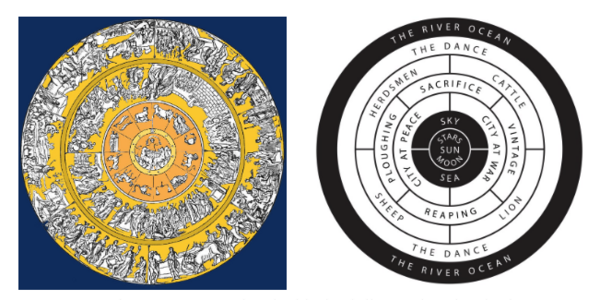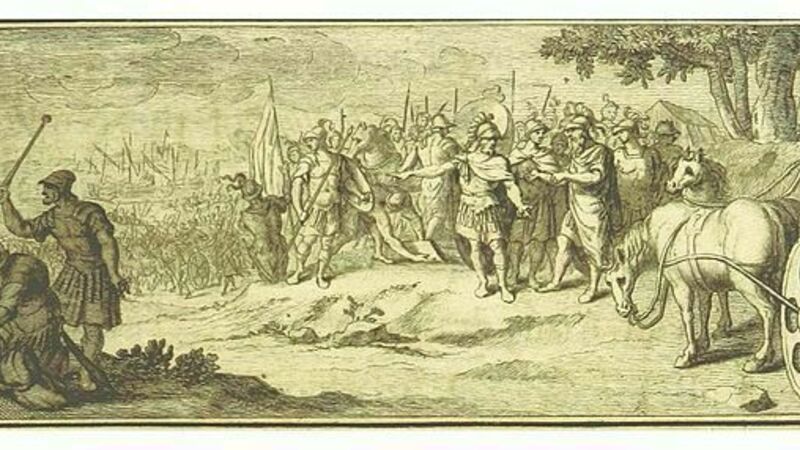War is both an ever-present facet of human society as well as a very captivating theme in fictional films, novels, and plays, as is proven by recent movies such as Saving Private Ryan or novels like Battle Cry of Freedom. This current fascination of war begs the question: where did this phenomenon come from and has this fascination changed across time? This paper will examine these issues further by looking at the ancient Greek and Roman societies who have given us two famous epic poems, Homer's Iliad and Virgil's Aeneid. Both works share the presence of gods and heroes and, most especially, examine warfare as their main theme, with the Iliad making it the driving force of the entire plot, while in the Aeneid it is the catalyst of the epic's climax.
Upon closer examination, however, these similarities are not the only aspect which characterize these two poems. This paper will highlight the difference in the portrayal of warfare between the Iliad and the Aeneid, suggesting a shift in ideology across cultures and generations, which still affects our contemporary world.
In Section 1, I will discuss the portrayal of warfare in the Iliad by focusing on the characters of Diomedes and Achilles. Then, in Section 2, I will explore the Aeneid's approach to the same topic by exploring both Turnus and Aeneas' involvement with it. In both Sections, I will connect the portrayal of warfare to societal views of the people within the same poems. To conclude, I will offer a detailed comparison between the shield of Achilles and that of Aeneas, which subtly reinforces the difference in the portrayal of war between the Iliad and the Aeneid. I will then conclude by discussing whether any of these two portrayals of warfare may relate to our contemporary society.
I. Warfare Within the Iliad: A Permanent Condition
In Homer's Iliad, an eighth century B.C. epic recounting the final events of the Trojan War and the siege of Troy, war is introduced as a permanent condition that is necessary to maintain civilization. Throughout the poem, war serves as a ground of eternal honor and perpetuated destruction, and we begin to see both features in the characterization of Diomedes, one of the strongest Greek heroes.
Upon his first presentation in the poem, Diomedes is in the midst of slaughtering the Trojan army and states that no one should ever "talk to [him] about retreating/ It's not in [him] to dodge a fight" (Homer 5.268-9). Diomedes is an active, prideful, and unyielding hero, who continuously pushes forward, despite being urged to stay back, since war is an "integrated part of their society and the birthplace of honor" (Rossman 42). As the poem progresses, Diomedes urges his men that there is "no lagging behind…Now we kill men! [There] will be plenty of time later/ To despoil the Trojan dead" (Homer 6.69-72). These words highlight war as perpetuation of destruction within the Iliad. There is no end in sight to the fighting amongst the Trojans and Greeks as "the battle was not over" (Homer 16.302), indicating that in the Iliad war is inherently a permanent condition of society.
In addition to Diomedes, Achilles offers further material for our analysis. This famous hero fights war out of love for his friend and for harvesting glory. As he returns to the battlefield in the second half of the Iliad, Achilles does not fight out of duty to his state or gods, but because Patroclus "is dead/ And [Hector] killed him" (Homer 18.86-7). Affection for Patroclus moves Achilles to kill Hector and drag his corpse behind his chariot (Homer 23.14-29) in order to defile the body of the enemy responsible for his friend's death. Achilles also understands that war is a breeding ground for eternal glory, so he goes to war "now to win glory" (Homer 18.130). Ultimately, in the Iliad, eternal glory is combined with "unrelenting feelings of love and revenge … to highlight war's role" (Rossman 45).
This impossibility of eradicating war from society is suggested by Book 24 of the Iliad, when Achilles and Priam share an exceptional moment of peace. When the latter asks the former for Hector's body back, Achilles inquires "how many days do you [Priam] need for the funeral?/ I will wait that long and hold back the army" (Homer 24.708-9). Although peace is made between Priam and Achilles, it is temporary and cannot last long since war needs to continue past the armistice; in the Homeric society, war is inevitable in nature and permanent.
II. Warfare Within the Aeneid
As time and culture progress to the Roman era, the portrayal of war evolves from an individual-driven and permanent condition necessary for the making of heroes, to a temporary one that brings about peace and civilization in the society as a whole. This shift is evident in Virgil's Aeneid, a First Century B.C. epic detailing the mythology surrounding the founding of Rome.
In this poem, a new view of war is introduced, particularly through the comparison between the antagonistic Turnus and the heroic Aeneas who battle for the control of Latium, which later becomes the settling ground for Rome. However, a clear shift from the Iliadic views of war becomes evident with Turnus, who embodies Greek values of war, which ultimately brings about his downfall.
From the beginning of his characterization, Turnus is portrayed as an Iliadic hero, since he fights in order to marry Lavinia and gain glory through his political alliance with her father (Virgil 7.366-72). Turnus' desire for glory is also visible when in the midst of battle, for he shouts to his enemy: "Pallas is mine now, my prize alone" (Virgil 10.521). As argued by Semple, the war narrated in Books 7 to 12 of the Aeneid is "waged solely on behalf of Turnus' personal ambitions"(224), which echoes the Iliadic ideology regarding warfare. Finally, the parallel between Turnus and Iliadic heroes is reinforced by the fact that the former is characterized as an aggressive animal: "the wolf rages, desperate…frenzied with building hunger, starved so long,/ his jaws parched for blood" (Virgil 9.71-4). This animal imagery reminds us of Achilles' portrayal as a savage lion or as an aggressive wolf in the Iliad (Homer 22.261-6).
However, this Greek perspective of war comes to an end with Turnus, for his downfall does away with this ancient ideology. In Book 12 of the Aeneid, when Turnus is in the midst of battle, he is characterized as "less avid…exulting less and less" (Virgil 12.710-1). From there, the tides turn against him, as "the fatal spear of Aeneas streaks on…strikes home and the blow drops great Turnus…His breath fled" (Virgil 12.1068-112). With Turnus' downfall and death, the Greek notion of the permanency of war is criticized and, to a point, ended.
While challenging this Greek model, the Aeneid offers a new approach to warfare through Aeneas. In direct contrast to Turnus, Aeneas is reluctant to fight a war and does so only out of a sense of duty to the gods and his people. In Book 4, when Aeneas is in Carthage with his beloved Dido, Mercury, the divine messenger, reminds him that "The King of the Gods…bear[s] commands for you to…shoulder the task" since "you owe him Italy's realm, the land of Rome" (Virgil 4.333-42). Moved by this sense of duty, Aeneas leaves his beloved Dido and sets sail "for Italy—/all against [his] will" (Virgil 4.450-1), where he is called to fight the war against Turnus. Through this process, Aeneas understands that his fighting is "driven by duty" (Virgil 4.495) and not by personal gain, thus differentiating himself from the Greeks' motivations in the Iliad.
Further, the shift from Greek to Roman ideals of war is reinforced by the fact that Aeneas fights for the sake of Latinus' city (Virgil 6.1023-5) and the future foundation of Rome. For Aeneas, therefore, war is not a permanent state of society that is used to gain individual glory, but rather a temporary condition employed in order to bring about peace in his civilization. When Aeneas fights, he often adopts passive strategies, as in his battle against Turnus (Virgil 9.47-53), and he acts "with no purpose of conquest" (Semple 1953, 211). In addition, before fighting, when he visits the Underworld in Book 6, "Aeneas has the vision to see beyond the war" and the foresight to contemplate "the Golden Age" (Virgil 6.915), namely the age of peace and prosperity which he will bring back. To conclude, Aeneas serves as the paradigm for the Roman view of war, which is a temporary state bringing about peace and civilization.
III. The Shields: An Everlasting Reality Versus a Prophecy
In the previous sections, I have argued that the main characters of both the Iliad and the Aeneid reflect the poems' different view of warfare: in the former poem, war is permanent, while in the latter it is a temporary condition which leads to peace within Roman culture.
This difference is further highlighted by a detailed comparative analysis of the shields of Achilles and Aeneas, both of which are described in detail in two important sections of the Iliad and the Aeneid respectively. As my analysis will show, both shields provide confirmation of the two poems' view of war, but they perform this function in two different ways: the Iliadic shield does this indirectly, by means of a counterfactual image, while the shield of Aeneas in a more simple and direct way.
In the Iliad, the shield of Achilles contains a series of inner circles, the second of which offers the image of a city at war where "their leaders were at odds…and the citizens wouldn't surrender" (Homer 18.511-13).

While this image seems at first to imply that the shield is mirroring the main themes of the Iliad, this impression is quickly dismissed as the shield expands outwardly, and images of "gods in their glory" (Homer 18.560), "vineyards loaded with grapes" (Homer 18.604), and "young men and girls in the prime of their beauty" (Homer 18.637) plaster the shield. Through these images, in Taplin's excellent interpretation, the readers "encounter…prosperity and people delighting in their lives" (346).
In light of this focus on prosperity, the shield of Achilles offers an image of Greek civilization that is counterfactual to the Iliadic society, which, as we know, is instead characterized by violence and sorrows of warfare. By reading the description of this shield, therefore, the readers are invited to go back to the entire poem and, by contrast, notice its focus on warfare as a permanent condition. Within this reading, the abovementioned city at war also plays an important role, since, as argued by Taplin, this city, being just one of the many subjects of the shields, "puts war and prowess into perspective within the world as a whole" (357).
Ultimately, the shield of Achilles provides an indirect confirmation that in the Iliad war is permanent condition of civilization, since the alternative offered to this model neither find a place in the poem, nor in Greek culture as a whole.
In Virgil's Aeneid, the shield of Aeneas provides a similar confirmation of the poem's view of warfare, but it does so in a different way from the Iliadic shield. Virgil does not introduce a counterfactual, but, more simply, uses the shield to tell a version of Roman history which focuses on the results of Roman warfare and matches the approach to war of the entire poem.

This history includes "the story of Italy/Rome in all her triumphs" (Virgil 8.738-9), which will start after Aeneas' victory. Moreover, when attention is given to a battle, in this case the "battle of Actium" (Virgil 8.790), this specific image of war focuses not on the violence of the fight but on the triumph of Caesar, the bearer of peace and civilization, as "Caesar is in triple triumph, / borne home through the walls of Rome" (Virgil 8.836-7).
Finally, Aeneas' reaction to the shield is also important, as this hero "fills with wonder/—he knows nothing of these events but takes delight…in the fame and fates of all his children's children" (Virgil 8.853-6). Here Aeneas does not admire war, but rather the main effect of war, which is the birth of Roman civilization. In this way, the shield confirms the temporary nature of war in the Roman society and its contribution to the good of the community.
To conclude, in the Iliad and the Aeneid, the shields of their two main heroes provide confirmation of these poems' different view of warfare.
Conclusion
Although they belong to the same genre and share many themes, both the Iliad and the Aeneid offer two extremely different images of war. According to Homer, war is a permanent and individual-driven aspect of human society, whereas Virgil interprets it as a temporary means to a civilizing end. These contrasting images serve as representations of how each respective society viewed war, and ultimately highlight the existence of an evolution from the Greek to the Roman culture.
What can we learn from the study of these ancient poems and, more specifically, from this evolution of war? After two thousand years have passed, does either the Greek or Roman view of war relate to our contemporary society, or have we taken a step further in the approach to this important and dramatic aspect of human society? In the short space of this conclusion, I will suggest that contemporary American epic works do highlight a further step in this developing view of warfare.
American novels, such as The Things They Carried or All the Light We Cannot See, or movies, like Full Metal Jacket and Generation Kill, all highlight the brutality and monotony of war, and, more importantly, extend the brutality to its lasting effects, by focusing on the soldiers' return home through descriptions of Post-Traumatic Stress Disorder (the psychiatric disorder affecting persons who have seen or experienced traumatic events). In doing this, our contemporary society shows to have taken some distance away both from the Greek and Roman views of war since, for us, war is neither a permanent condition of our society nor a means of preserving civilization but rather a condemnable evil which outweighs any good it may bring.
On the other hand, the flourishing of superheroes and superheroines throughout the last century, culminating in comics books and movies focused on Iron Man, Captain America and Wonder Woman, suggests that the Roman conception of war is not fully detached from us. The notions of fighting for the good of one's country in order to defeat evil is still part of our contemporary American society, although it is now perceived with some more skepticism than in the past, as seen in films like Avengers: Civil War and Hiroshima: The Real History.
If we truly want to understand the value of warfare in our society, therefore, we need to go back to the Iliad and the Aeneid, since they can illuminate both the origin and the originality of the contemporary view of war.
Works Cited
@DigitalMapsAW. "The Shield of #Aeneas was forged by Vulcan. It depicts the future of #Rome, such as #Romulus being nursed by the she-wolf, the defeat of the Gauls and #Caesar #Augustus as he defeats #Antony and #Cleopatra at the Battle of #Actium. #MythologyMonday." Twitter. 12 Aug. 2019, 9.53a.m. https://twitter.com/digitalmapsaw/status/116091225...
Homer, et al. Iliad. Hackett Publishing Company, Inc., 1997.
Mulligan, Bret. "Diagram of the Shield from 'The Iris Center." Tales of Troy, 20 Sept. 2018, iris.haverford.edu/troy18/2018/09/20/shields-of-achilles/.
Rossman, G., "Glory and Gore." Contexts, 16(3), 2017, 42-47, https://doi.org/10.1177/1536504217732052.
Semple, W.H. "War and Peace in Virgil's Aeneid," Bulletin of the John Rylands Library. 36.11, 1953. 211-227.
Taplin, O. (1980), "The Shield of Achilles Within the Iliad." Greece and Rome 27.1, 1-21. The Shield of Achilles. www.geneseo.edu/~walker/ShieldofAchilles.htm.
Virgil, et al. The Aeneid. Penguin Classics. 2003.
Discussion Questions
- Which key elements can you identify in the introduction of this essay? What is the function of the third paragraph starting with "In Section 1"?
- How is the evidence from the ancient texts used in Section 1 of this essay? How is the evidence distributed across the section?
- In Section 2, what is the function of the two first paragraphs? Do you think that the writer could have avoided writing them?
- What is the function of the conclusion of this essay? Does it add anything to the argument of the essay?

